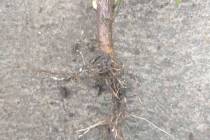No need to fertilize bougainvillea
QBefore the first freeze in Las Vegas what should I feed my bougainvillea? I have three plants, all in the ground. They are 6 years old and I wrap their bases before the freeze. They always come back come March and bloom beautifully August through October.
A. I like your idea of wrapping the bases of the plants before any freeze. That winter freeze is likely to occur from the first week of December to the first week of March.
Unless you have a very warm microclimate in your yard, and there are some in Las Vegas, you will see damage to them at the first light freeze with temperatures below 32 degrees F.
Wood mulches will also protect the base of bougainvillea but wrapping it is more effective. This way when it freezes it will kill the top of the bougainvillea to the mulch or wrap and not much further.
Of course this works to temperatures below freezing for short periods of time. If the temperatures are extremely cold or at these temperatures last a long time that it may freeze the plant to the ground.
How well you protect the base of the plant will determine how strong it will come back, or not, next spring. Having bougainvillea in the spot in the yard that does not have a lot of wind and is close to a warm, south or even better yet, west-facing wall will improve its chances for survival.
Plants that freeze to the ground will come back like gangbusters next spring because of their established root system. Plants that are planted in the spring have to grow both the roots and the tops and so growth is divided between the two. Plants that have an established root system only have to grow the top back and so all of that growth goes to top growth and we see huge amounts of growth in the spring.
You do not want to feed them anything this time of year. This goes for any winter-tender plant. These plants should get no fertilizer applied to them any time after mid-August. Fertilizers that stimulate new growth will cause the plant to become more succulent and lower its chances of surviving winter freezes.
This is not true of plants that have no problem surviving winter freezes. In fact, those plants can receive midfall applications of fertilizer with no problems. A midfall application of fertilizer can substitute for a spring application but not for winter-tender plants.
Q. This question regards our bottle tree. Should we trim and shape the tree? It has grown to a considerable height. The wind, appearance, and health of the tree are our concerns. Does the cracking on the trunk need addressing? And should I wrap the trunk in winter?
A. Very nice looking tree. I posted the picture you sent me on my blog. Personally, I would not do anything to it. The cracking in the trunk is normal for an aging tree. It should not have difficulty handling a normal winter.
I know it may not look picture perfect but that is what can be charming about these types of trees used in our environment. As it grows, it will naturally fill in some of the voids.
You could prune it to shape it a bit but be very careful when you do this and do not change it radically or the plant may respond in a way that you may not like.
Don’t do anything dramatic to it or you could end up with some problems such as sunburn on the lower limbs and, consequently, dieback. If you are going to do some pruning, do it this winter and hire someone who has a good reputation with shaping trees.
Bob Morris is a horticulture expert living in Las Vegas and professor emeritus for the University of Nevada. Visit his blog at xtremehorticulture.blogspot.com.











